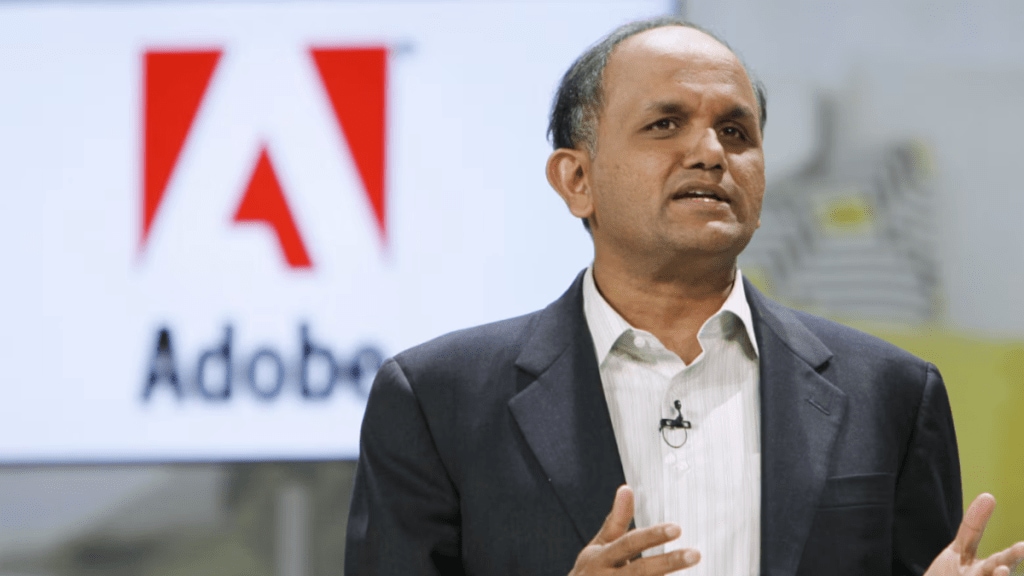Speaking at the inaugural session of WAVES 2025 in Mumbai, Adobe chairman and CEO Shantanu Narayen emphasised that India’s next economic boom would stem from its creative economy rather than software or manufacturing. Narayen’s statement highlights a shift in the global perception of India, not just as a backend for tech, but increasingly as a hub for content creation and intellectual property (IP) generation. His comments align with the growing media and entertainment (M&E) sector in India, which crossed Rs 2.5 lakh crore in 2024 and continues to grow at a 7% CAGR.
Adobe’s strategic move into India’s creative ecosystem
In line with the growing potential of India’s creative sector, Adobe is expanding its efforts in the country’s skilling and creative ecosystems. With over 1 billion users globally, the company aims to train 2 crore students and 5 lakh teachers as part of its educational partnerships in India. Furthermore, Adobe is enhancing its AI capabilities for products like Illustrator and Acrobat, being developed in India, reinforcing the country’s role in shaping future creative tools.
Adobe’s Firefly AI tool was highlighted at WAVES, showing how it can assist regional creators in tasks like dubbing content, stylising videos, and speeding up post-production—all in local languages. This shift toward hyper-local content is a growing trend, as platforms demand more region-specific material. The increasing demand for such localised content positions tech tools as enablers of monetisation for creators in smaller towns.
Creative jobs and economic impact
One of the key highlights from Narayen’s address was his direct comparison of creative jobs with those in manufacturing. He predicted that India’s creative economy could eventually employ more people than its manufacturing sector, as industries like digital design, animation, filmmaking, and gaming gain traction as formal employment streams. This shift also aligns with the government’s identification of the AVGC-XR (Animation, Visual Effects, Gaming, Comics, and Extended Reality) sector as a potential contributor to both GDP and exports. In this context, WAVES 2025 is positioning itself as India’s answer to global events like MIPCOM and CES.
India’s creative economy at WAVES
At the Bharat Pavilion inside WAVES’ “Kala to Code” zone, Indian creators presented over 2,000 film, series, and animation pitches using Adobe’s suite of creative tools. Major global platforms, including Netflix, Disney, and Amazon, were among the international buyers present, reflecting growing global interest in Indian-origin content. Adobe’s Content Authenticity Initiative, a global standard to watermark AI-generated content and combat issues like deepfakes, was also highlighted, with over 3,000 companies, including Indian production houses, reportedly participating.
Challenges facing India’s creative economy
Despite the growing momentum, several challenges remain. India’s creative workforce remains largely informal, with digital access still inconsistent across regions. Only 60% of the population has reliable internet access, which continues to hinder the widespread adoption of creative tools. Furthermore, AI tools like Firefly, while empowering, have raised concerns within the artistic community about automation’s impact on content ownership and job security.
Adobe’s new initiatives at WAVES 2025
In a move aimed at further supporting the Indian creative economy, Adobe announced a series of strategic initiatives at WAVES 2025, which are aligned with the Indian Government’s vision to foster creative talent both domestically and globally. These initiatives include new collaborations with WAVES Bazaar, Tata Consultancy Services (TCS), the Indian Institute of Creative Technology (IICT), and Accenture—partnerships that are geared towards equipping the next generation of creators with Adobe’s creative tools.
Adobe also unveiled several localised updates to its tools. For instance, Adobe Express, which has tripled its number of active users in India, now offers features in eight Indian languages, making it more accessible to a diverse range of creators. Adobe also announced plans to launch 1 million new localised templates, with pricing strategies designed specifically for the Indian market.
Additionally, Adobe is partnering with TCS to establish an AI-powered Creative Experience Studio (ACES) aimed at delivering culturally relevant and high-impact content for businesses and public sector enterprises in India. This collaboration will leverage Adobe’s technology alongside TCS’s expertise in digital services to create personalised marketing experiences.
Education and Workforce Development
Education and skill-building also remain a focal point of Adobe’s strategy in India. In collaboration with the Indian Institute of Creative Technology (IICT), Adobe plans to provide free access to Creative Cloud for students and teachers, alongside curriculum development, faculty training, and student mentorship. Further, Adobe has signed an MoU with Accenture to upskill students from over 50 design institutes across India, aiming to create pathways for internships and employment for young talent.
The road ahead for India’s creative economy
India’s creative economy presents significant potential, but challenges like uneven digital access, informal employment structures, and concerns around AI and automation will need to be addressed for the sector to reach its full potential. As India continues to grow as a hub for content creation, collaborations between the government, global companies like Adobe, and local educational institutions will play a critical role in shaping the future of India’s creative workforce.
The unfolding story of India’s creative economy, driven by a new generation of skilled creators and bolstered by technological advancements, will continue to capture the attention of both domestic and international stakeholders in the years to come.

